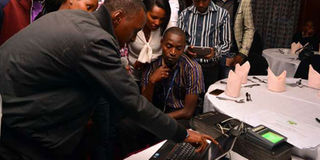We need manual verification of voters

Independent Electoral and Boundaries Commission (IEBC) ICT Systems Administrator Meikan Gabriel demonstrates how voter registration is done, at Nairobi Safari Club on January 9, 2017. A manual system as a back-up has been introduced. PHOTO | DENNIS ONSONGO | NATION MEDIA GROUP
What you need to know:
- However, these rules need to ensure that the reason the contest is being held in the first place is not lost.
- Manual verification should not be misconstrued to mean using the physically printed register or green book.
The reasons that triggered the call to amend the elections laws are getting lost in the rather heated debate on manual versus electronic verification of voters.
This, unfortunately, has generated more heat than light.
The Election Amendment Act 2016 has raised the profile of technology from just being a tool to be used in boosting confidence to being the exclusive means of conducting voter identification and results transmission.
There is no electronic voting in Kenya, nor is it being discussed.
What we have are electronic processes that facilitate paper-based voting.
Voters are registered electronically by capturing their biometric features — facial and fingerprints.
On voting day, they are verified electronically before being issued with ballot papers, which they mark and drop into the ballot box.
The ballots are counted manually and the results are transmitted electronically.
The rules that are to be used to verify voters are currently at the crux of the debate, and especially the role of technology in determination of enfranchisement.
Electoral processes are contests and for them to be successful, the rules should be well known, accepted, and understood by all players.
These rules should be predictable and, above all, perceived to be fair.
However, these rules need to ensure that the reason the contest is being held in the first place is not lost.
TECHNOLOGY FAILURE
The issues around the failure of technology have been well documented.
The Independent Electoral and Boundaries Commission (IEBC) conducted an internal audit of the March 2013 election and rather candidly highlighted the failures.
In the identification of voters electronically, the problems fell broadly into three categories — technology, procurement, and rollout.
Most of the procurement and rollout problems can be resolved using proper planning and management.
The technological problems are not so easy to deal with as some are based on the limitation of the technology and the data collected.
During registration, in addition to biographical data, the IEBC captured the photograph and fingerprints of most voters.
The inconvenient reality is that in any population, there are always people whose fingerprints are difficult or impossible to capture or verify.
This raises a fundamental ideological question of whether a person should be disenfranchised because of the limitations of technology.
In 2012, Ghana went into its election with the No [biometric] Verification, No Voting (NVNV) mantra and the voting period had to be extended due to technology issues, which disenfranchised many people.
For the 2016 election, Ghana rolled back the NVNV and created provisions for manual verification, which required the presiding officer to fill a form for each voter who was manually verified.
The process used for verification usually involves a one-on-one match of voters against their biometrics.
The voter gets his/her ID number captured by the verification device.
Once his/her records are loaded on the device, an additional fingerprint scan is required to verify the person.
DETECTING ANOMALIES
Since the devices require no connectivity to verify/identify voters as they are self-contained, the verification process should work for most voters.
In the few cases where the validation device is unable to verify the fingerprint of a voter whom the presiding officer knows or strongly believes to be a legitimate voter, and his/her particulars are on the voter register, the presiding officer should have the authority to override the device and allow the person to vote.
My proposal is that in order to trigger the manual verification process, the presiding officer should both physically and electronically collect as much information about the person being excluded from being electronically verified as possible.
This information should include a photo of this person and the serial number on their national identification card, not the ID card number.
Manual verification should not be misconstrued to mean using the physically printed register or green book.
This process should be endorsed by all party agents present at the polling station.
This information can be transmitted periodically to all stakeholders to assist in identifying polling stations that have inordinately high numbers of exceptions and vigilance can be increased to ensure that only legitimate cases are excluded from electronic verification.
All final reconciliations should include the number of decisions the presiding officer made contrary to the technology. This will allow interested parties to detect anomalies.
Mr Ngumi is an election technology adviser. [email protected]




